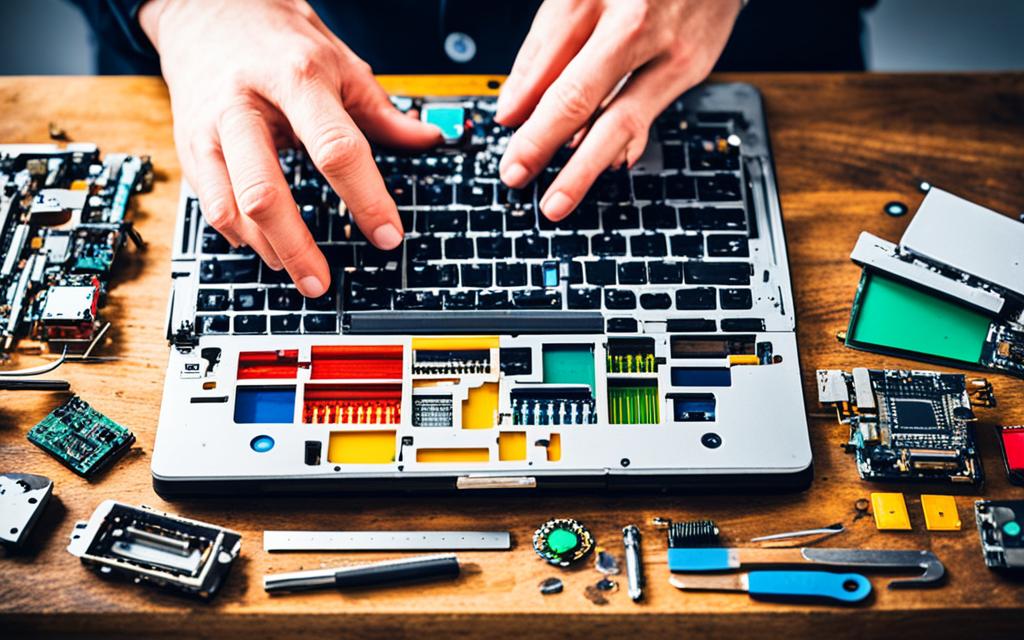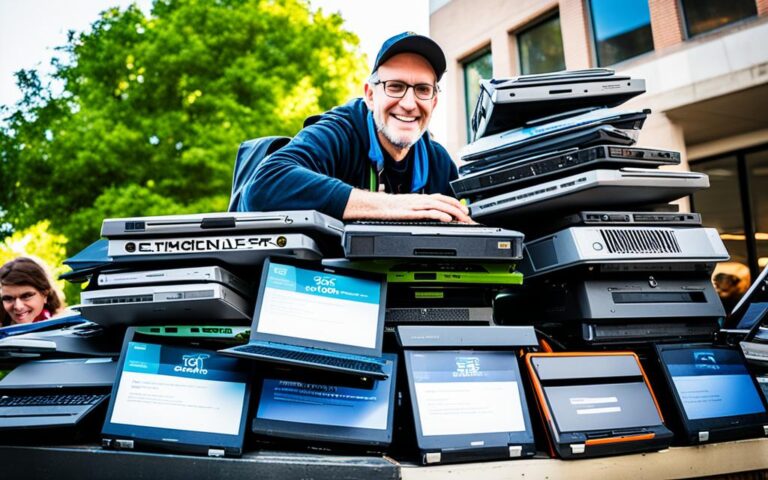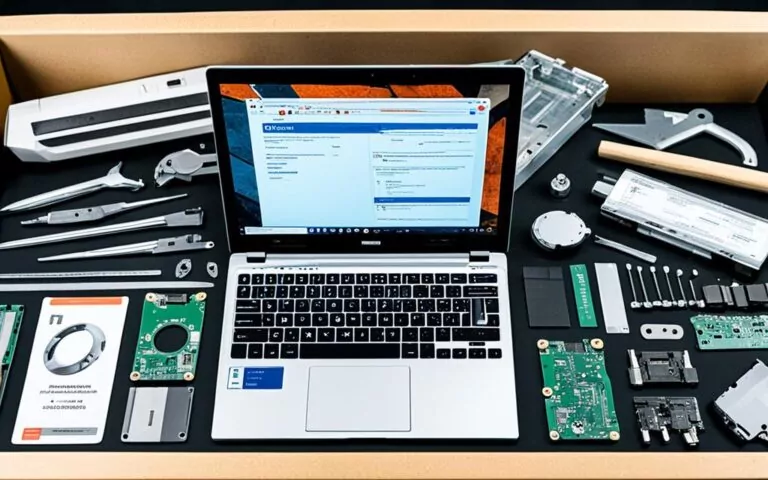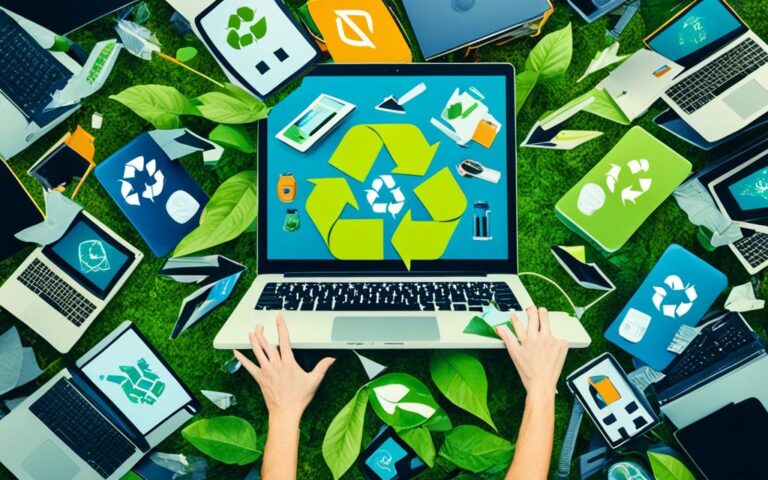Upcycling Laptops: From Obsolete to Functional with a Creative Twist
In today’s fast-paced world of technology, laptops quickly become obsolete, leaving many individuals unsure of what to do with their old devices. However, there is a sustainable solution that not only repurposes these laptops but also gives them a new lease on life. Welcome to the world of laptop upcycling.
Upcycling laptops involves transforming them into functional and stylish products through innovative and creative processes. By repurposing old laptops, we can extend their lifespan, reduce waste, and make a positive impact on the environment.
Upcycling laptops is a form of sustainable laptop usage that goes beyond simply recycling them. Instead of sending laptops to landfills or recycling centers, where they may still end up producing waste, upcycling brings new life to these devices.
The process of upcycling laptops involves repurposing old components, salvaging usable parts, and integrating them into new designs. This can include transforming laptops into unique pieces of furniture, creating art installations, or even repurposing them into other electronic gadgets.
By repurposing old laptops, we not only minimize waste but also tap into the creative potential of these devices. With a little imagination, obsolete laptops can be given a second chance to shine, showcasing their versatility and functionality in ways that may surprise you.
If you have an old laptop gathering dust in a drawer or closet, consider the possibilities of upcycling. You can contribute to sustainable laptop usage, promote repurposing, and enjoy the satisfaction of breathing new life into old technology.
Join us as we explore the world of upcycling laptops and discover the endless possibilities of repurposing old laptops in creative and innovative ways. Through laptop upcycling, we can make a positive impact on the environment and create a more sustainable future.
Upcycled Furniture: Giving New Life to Old Materials
When it comes to sustainable living, upcycling and repurposing are key practices that can make a significant difference. One area where these practices truly shine is in the world of furniture design.
Enter Reclaimed Wood Designs, an innovative startup that specializes in creating unique furniture pieces from reclaimed wood. Rather than letting these materials go to waste, the talented team at Reclaimed Wood Designs salvages wood from old barns, factories, and shipping pallets, giving new life to these forgotten materials.
Through their skillful craftsmanship, they transform the reclaimed wood into stunning dining tables, coffee tables, and shelving units that are not only beautiful but also sustainable. By opting for upcycled furniture, individuals can embrace sustainability while adding a creative twist to their home decor.
What sets upcycled furniture apart is its ability to marry sustainability with style. Each piece carries its own history, showcasing the character and charm that comes from repurposed materials. Whether it’s the warmth of weathered barn wood or the rich texture of salvaged pallets, these tactile details make each creation truly unique.
Redefining Waste: The Upcycling Process
Reclaimed Wood Designs takes great care in the upcycling process, ensuring that every piece is crafted with precision and attention to detail. The furniture is carefully designed to highlight and preserve the natural beauty of the reclaimed wood, allowing its inherent qualities to shine through.
“Our goal is to showcase the artistry and craftsmanship of repurposed materials, while also creating functional and beautiful pieces for our customers,” says Emily Wright, the founder of Reclaimed Wood Designs.
By upcycling discarded materials, Reclaimed Wood Designs not only reduces waste but also helps to lessen the demand for virgin resources. This sustainable approach contributes to the preservation of forests and ecosystems, making a positive impact on the environment.
Unleashing Creativity: Inspiring Home Decor Solutions
One of the most exciting aspects of upcycled furniture is the endless creativity it inspires. Whether it’s a dining table showcasing the unique patterns of salvaged planks or a coffee table crafted from reclaimed factory beams, these pieces bring a touch of authenticity and character to any space.
The versatility of upcycled furniture is another reason for its growing popularity. It seamlessly blends with a variety of interior design styles, from rustic farmhouse to modern industrial. By incorporating upcycled furniture into their homes, individuals can express their personal style while making a statement about their commitment to sustainability.
Reclaimed Wood Designs is just one example of the many inspiring initiatives in the world of creative furniture upcycling. As more individuals and businesses embrace this sustainable design trend, we can reduce waste, preserve resources, and create a more beautiful and eco-friendly world.
Repurposed Fashion: Redefining Sustainable Style
The fashion industry plays a significant role in our lives and our planet’s well-being. It’s a major contributor to pollution, waste, and resource depletion. However, a new wave of sustainable clothing brands is emerging, focusing on repurposing materials and promoting eco-friendly fashion. One such brand leading the charge is ReFibered.
ReFibered is a pioneering startup that collects textile waste from factories and transforms it into high-quality yarn. This repurposed yarn is then used to create stylish and sustainable clothing items, such as sweaters, scarves, and shoes. By repurposing discarded textiles, ReFibered not only reduces waste but also promotes a circular economy in the fashion industry.
| Benefits of Repurposed Fashion | The Impact of Repurposed Fashion |
|---|---|
|
|
Embracing repurposed fashion not only allows individuals to make a style statement but also make a positive impact on our planet. By choosing sustainable clothing options, we can collectively minimize textile waste, conserve valuable resources, and contribute to a more sustainable and circular fashion industry.
So, join the fashion revolution and embrace repurposed fashion to redefine your style and create a more sustainable future.
Upcycled Packaging: Rethinking Waste in the Food Industry
EcoPacks is a startup that specializes in producing upcycled packaging for the food industry. By repurposing agricultural waste, they offer sustainable and eco-friendly packaging solutions to replace traditional single-use plastics. Instead of contributing to landfill waste, EcoPacks transforms materials like sugarcane bagasse and corn husks into biodegradable and compostable packaging.
This innovative approach has significant benefits for the environment. Not only does it reduce waste and minimize the use of non-renewable resources, but it also promotes the use of renewable agricultural materials. By tapping into these eco-friendly packaging solutions, the food industry can make a positive impact on the environment and contribute to a more sustainable future.
Take a look at the table below for a quick comparison between traditional single-use plastics and upcycled packaging:
| Traditional Single-Use Plastics | Upcycled Packaging |
|---|---|
| Derived from fossil fuels | Utilizes renewable agricultural waste |
| Long decomposition time | Biodegradable and compostable |
| Contributes to pollution and landfill waste | Reduces waste and promotes sustainability |
By choosing upcycled packaging, businesses can demonstrate their commitment to sustainability and appeal to environmentally conscious consumers. It not only helps reduce the environmental impact of food packaging but also aligns with the growing demand for more responsible packaging solutions. EcoPacks and other similar initiatives are driving innovation in the food industry and revolutionizing the way we think about packaging waste.
Quoting sustainability expert, Sarah Thompson:
“The shift towards upcycled packaging is essential in rethinking waste in the food industry. It offers a viable alternative to single-use plastics and showcases the power of creative solutions in promoting sustainability.”
Repurposed Electronics: Extending the Lifespan of Gadgets
TechRevive is a startup dedicated to the repair and enhancement of old smartphones, laptops, and other electronic devices. By extending the lifespan of these gadgets, TechRevive plays a significant role in reducing electronic waste and promoting sustainable technology consumption. In addition to their repair services, TechRevive also offers a wide range of refurbished gadgets at affordable prices, making it easier for consumers to choose eco-friendly options without compromising on quality. Through their efforts in upcycling and repurposing electronics, TechRevive not only minimizes waste but also contributes to the circular economy by keeping valuable resources in circulation for longer periods.
Upcycled Art: Transforming Trash into Treasures
WasteArt is a startup that collaborates with artists to create stunning sculptures, paintings, and installations using discarded materials. These artists transform trash, such as plastic bottles and old bicycle parts, into treasures, highlighting the beauty that can be found in repurposed materials. WasteArt not only raises awareness about waste but also inspires others to rethink their own consumption habits. Upcycled art showcases the creativity and resourcefulness in transforming trash into captivating artworks.
“Upcycled art is a powerful form of expression that challenges our perception of waste. By transforming discarded materials into beautiful works of art, WasteArt reminds us of the potential value found in even the most overlooked objects.”
– Sarah Thompson, Art Critic
Artistic Transformations
The artists partnered with WasteArt push the boundaries of creativity by experimenting with a diverse range of repurposed materials. Plastic bottles are sculpted into intricate forms, old bicycle parts are transformed into vibrant installations, and discarded fabrics find new life in captivating tapestries. Through their art, these innovative individuals redefine traditional notions of creativity and challenge the conventional art world.
A Catalyst for Change
Upcycled art serves as a catalyst for change by shedding light on the environmental impact of waste and the importance of sustainable practices. WasteArt’s exhibitions and installations provoke thought, encouraging viewers to question their own consumption habits and consider the transformative potential of repurposing materials. By showcasing the beauty and value of upcycled art, WasteArt inspires individuals and businesses to explore creative and sustainable solutions in their own lives.
The Intersection of Art and Sustainability
The collaboration between waste transformation and art highlights the intersection of creativity and sustainability. Through the lens of upcycled art, we recognize that waste can be reimagined, repurposed, and transformed into something meaningful. WasteArt’s vision extends beyond creating visually appealing artworks; it aims to be a driving force in promoting a more conscious and sustainable society.
Engaging the Audience
WasteArt actively engages audiences through interactive workshops, art installations in public spaces, and educational programs. By involving the community in the creative process, WasteArt fosters a sense of ownership and responsibility for waste reduction and sustainable practices. Through these initiatives, WasteArt empowers individuals to unleash their own creativity and reimagine the potential of discarded materials.
| Benefits of Upcycled Art | Statistics |
|---|---|
| Environmental Impact | Upcycled art reduces the amount of waste that ends up in landfills and contributes to a more circular approach to resource utilization. |
| Creative Inspiration | Upcycled art sparks creativity and encourages individuals to think outside the box, inspiring innovative solutions to everyday challenges. |
| Community Engagement | Upcycled art initiatives foster community involvement, collaboration, and awareness, creating a network of like-minded individuals passionate about sustainability. |
| Educational Value | Upcycled art provides educational opportunities, teaching about waste reduction, repurposing, and environmental stewardship through artistic expression. |
Understanding the Circular Economy
The circular economy is a sustainable model that aims to minimize waste, maximize resource efficiency, and create a system where resources are continuously cycled and reused. By embracing the principles of the circular economy, individuals, businesses, and governments can work together to build a more sustainable and resilient future.
Principles of the Circular Economy
- Designing out waste and pollution: The circular economy encourages the design of products and systems that eliminate waste and pollution from the start. This involves considering the entire life cycle of a product and finding innovative ways to reduce environmental impact.
- Keeping products and materials in use: Instead of the traditional linear model of production and consumption, the circular economy aims to maintain products and materials in circulation for as long as possible. This includes strategies such as repair, refurbishment, and remanufacturing.
- Regenerating natural systems: The circular economy recognizes the importance of preserving and restoring natural resources and ecosystems. By adopting regenerative practices, such as ecosystem restoration and sustainable agriculture, it seeks to create a harmonious relationship between the economy and the environment.
Benefits of the Circular Economy
The circular economy offers a range of benefits that make it an attractive and necessary approach to sustainability:
- Resource efficiency: By maximizing the use of resources and minimizing waste, the circular economy reduces the strain on finite resources and promotes a more sustainable use of materials.
- Cost savings: Embracing circular economy principles can lead to significant cost savings for businesses. By eliminating waste, reducing raw material consumption, and finding value in waste streams, companies can improve their bottom line.
- Job creation: The circular economy has the potential to create new jobs and economic opportunities. As industries shift towards more sustainable practices, there is a growing demand for skilled workers in areas such as recycling, remanufacturing, and renewable energy.
- Environmental benefits: Perhaps the most important benefit of the circular economy is its positive impact on the environment. By reducing waste, minimizing pollution, and preserving natural resources, the circular economy helps mitigate the effects of climate change and promote ecological balance.
Embracing the circular economy is not only necessary for the well-being of our planet but also beneficial for businesses and individuals. By rethinking our approach to production and consumption, we can create a more sustainable and resilient future for generations to come.
Conclusion
In conclusion, laptop upcycling and the adoption of sustainable technology are key factors in building a more sustainable future. By repurposing old laptops and embracing sustainable practices in various industries, we can make significant contributions to reducing waste, conserving resources, and minimizing our environmental impact.
Through the efforts of innovative startups and creative initiatives, we have the ability to transform obsolete technology into functional and stylish products, promoting not only sustainability but also the principles of the circular economy. By embracing laptop upcycling and the circular economy, we can create a better world for future generations.
By embracing laptop upcycling and the principles of the circular economy, we can help create a more sustainable and resilient future. Together, we can make a positive impact on the environment and reduce our carbon footprint. Let us continue to explore and support these initiatives, promoting the ideals of a circular economy and sustainable living.
FAQ
What is laptop upcycling?
Laptop upcycling is the process of repurposing old laptops to give them a new function or purpose. Instead of discarding them as electronic waste, upcycling involves refurbishing and upgrading these devices to extend their lifespan and reduce environmental impact.
How can I upcycle my old laptop?
There are several ways to upcycle your old laptop. You can consider donating it to organizations that refurbish and distribute them to those in need. Alternatively, you can repurpose the laptop as a media server, home automation controller, or even a digital photo frame. If you’re feeling artistic, you can also transform the laptop into a unique piece of artwork or furniture.
What are the benefits of upcycled furniture?
Upcycled furniture offers numerous benefits. Firstly, it reduces waste by giving new life to old materials. Additionally, it adds a unique and creative touch to your home decor. Upcycled furniture is often more affordable than brand-new items and promotes sustainable living by reducing the demand for new furniture production.
How can I incorporate upcycled furniture into my home?
There are various ways to incorporate upcycled furniture into your home. You can start by selecting a standout piece, such as a reclaimed wood dining table or a shelving unit made from repurposed materials. Mix and match these pieces with your existing furniture to create an eclectic and sustainable home design.
What is repurposed fashion?
Repurposed fashion involves transforming discarded textiles and materials into new and stylish clothing items. Instead of contributing to textile waste, repurposed fashion promotes sustainability by giving new life to these materials. It offers a unique and eco-friendly way to redefine your style and reduce the environmental impact of the fashion industry.
Where can I find repurposed fashion items?
Several brands and startups specialize in repurposed fashion. You can explore online platforms and marketplaces that offer upcycled clothing and accessories. Alternatively, you can support local artisans and designers who create unique pieces using repurposed textiles and materials.
What is upcycled packaging?
Upcycled packaging refers to packaging materials that are created from repurposed or recycled materials. These materials include agricultural waste, such as sugarcane bagasse and corn husks, which are transformed into biodegradable and compostable packaging alternatives. Upcycled packaging reduces the use of single-use plastics and promotes sustainability in the food industry.
How can businesses implement upcycled packaging solutions?
Businesses can implement upcycled packaging solutions by sourcing packaging materials made from repurposed or recycled materials. They can collaborate with companies that specialize in upcycled packaging to develop environmentally friendly alternatives. Additionally, businesses can educate their customers about the importance of sustainable packaging and encourage them to support brands that prioritize upcycled packaging.
How does repurposed electronics contribute to sustainability?
Repurposed electronics contribute to sustainability by extending the lifespan of gadgets and reducing electronic waste. Instead of disposing of old smartphones, laptops, and other devices, repurposing involves repairing and upgrading them to functional conditions. This helps conserve resources and reduce the environmental impact of electronic waste.
Where can I find refurbished gadgets?
Refurbished gadgets can be found through various channels. You can explore online marketplaces that specialize in selling refurbished electronics, such as laptops and smartphones. Additionally, you can check with electronics retailers or manufacturers that offer refurbished options. Local repair shops or electronic recycling centers may also have a selection of refurbished devices.
What is upcycled art?
Upcycled art refers to artwork created using discarded materials or repurposed items. Artists transform these materials, such as plastic bottles or bicycle parts, into captivating sculptures, paintings, and installations. Upcycled art not only highlights the creativity and resourcefulness in repurposing waste but also raises awareness about the importance of waste reduction and sustainable living.
How can I support upcycled art?
You can support upcycled art by attending exhibitions and purchasing artwork created from repurposed materials. Additionally, you can support artists and organizations that promote upcycled art by sharing their work on social media and spreading the word about the importance of waste transformation and sustainability.
What is the circular economy?
The circular economy is a sustainable model that aims to minimize waste, maximize resource efficiency, and create a system where resources are continuously cycled and reused. It involves designing out waste and pollution, keeping products and materials in use, and regenerating natural systems. The circular economy offers numerous benefits, such as resource efficiency, cost savings, job creation, and environmental benefits.
How can I embrace the principles of the circular economy?
Embracing the principles of the circular economy can be done in various ways. You can start by prioritizing products made from recycled or upcycled materials. Choosing reusable and durable items over single-use products also aligns with circular economy principles. Supporting businesses that prioritize sustainability and resource efficiency is another way to embrace the circular economy.
What is the significance of laptop upcycling and the circular economy?
Laptop upcycling and embracing the circular economy play a crucial role in reducing waste, conserving resources, and minimizing environmental impact. By repurposing old laptops and adopting sustainable practices in various industries, individuals and businesses make a valuable contribution towards a more sustainable future. Through innovative startups and creative initiatives, obsolete technology can be transformed into functional and stylish products, fostering a circular economy and sustainable living.















